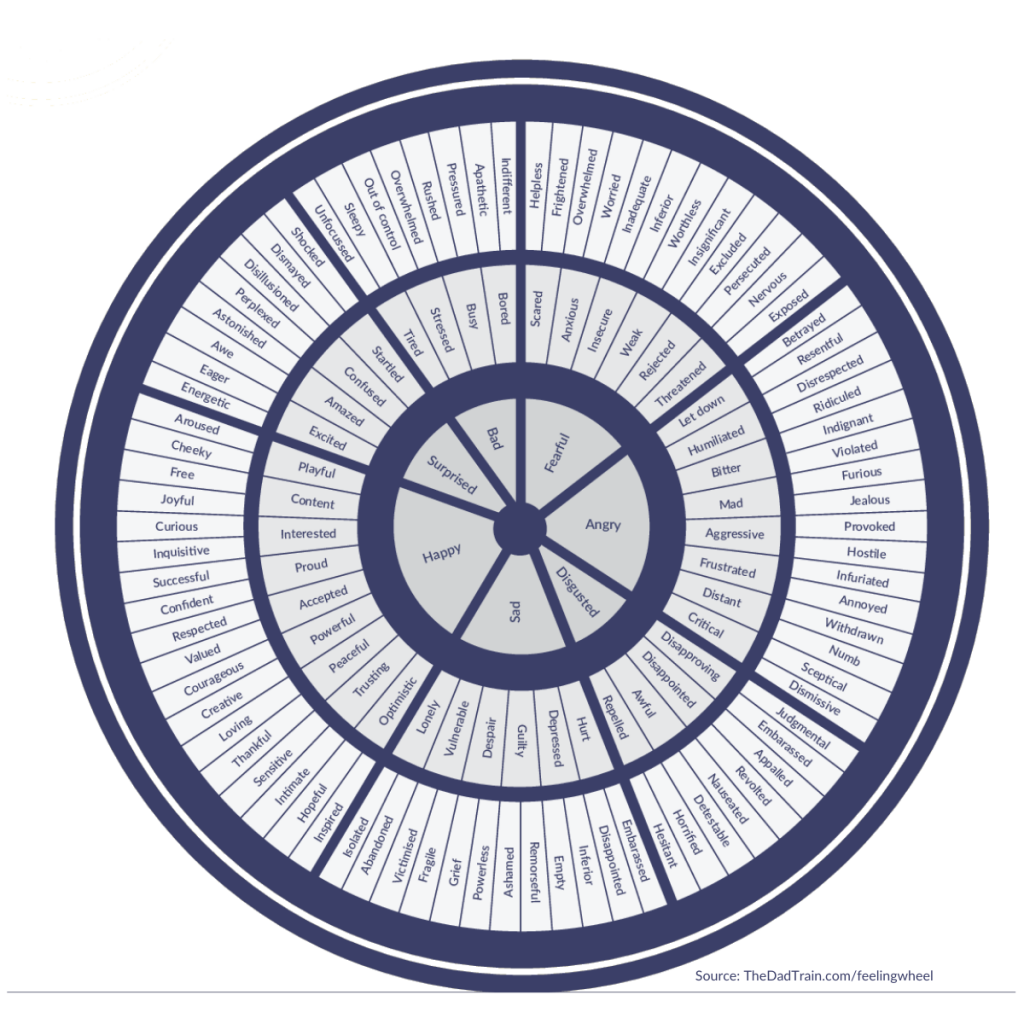Maybe emotions are like colours?
Recently, I found myself discussing colours with my partner. We had decided to paint the living room and were choosing between various shades of blue.
Whilst she was adamant of the differences, to me, they all looked very similar.
And what’s more, we were discussing colours I had never even heard of, such as uranian, munsell and periwinkle.
Now bear in mind, my partner is not a native English speaker. Yet she seemed to have a much larger vocabulary of colours than me. Plus, she was able to spot subtle differences, that to me were indistinguishable.
How could this be? Is it just me, or are women naturally better at identifying and labelling colours?
Well, it turns out, the answer is yes. Research has shown that women on average have a larger colour vocabulary than men. And due to physical differences in the visual cortex of the brain, they also have a more acute sense of colour detection, as explained here.
Of course, there are exceptions to the rule, but in general, this means women are better than men at perceiving and describing colours.
So it’s not just me then! But where am I going with this?
Well, just like colours, sometimes men have trouble identifying and labelling emotions. There are various reasons for this is which we will discuss later in the article. But for now, what we need is a solution. We need a tool to help develop our emotional literacy.
And here it is… Ladies and (especially) gentlemen – I give you THE FEELING WHEEL!
The Feeling Wheel

What is The Feeling Wheel and where does it come from?
American Psychologist Robert Plutchik first developed the idea of a feeling wheel in 1980. His version was called ‘The wheel Of Emotions’ or ‘The Emotions Circle’. It presented eight primary emotions (joy, sadness, acceptance, disgust, fear, anger, surprise and anticipation), which Plutchik believed were the foundations of all others.
A similar concept was used by Dr Gloria Wilcox in her book ‘Feelings : Converting Negatives to Positives‘. Her version displayed six core emotions presented on opposite sides of the wheel: sad, mad and scared (the negative emotions) and positive, powerful and joyful (the positive emotions)
However, the version of the wheel that I am using was created by an Australian Pastor named Geoffrey Roberts. He expanded the wheel to include 130 different feelings, with an increased focus on anger and fear (two common emotions that men struggle with).
Now I’m not suggesting this is a complete list of every emotion that humans can experience, far from it. And you will probably disagree with some of the groupings.
However, as a tool to help identify and label emotions, I have found this version of the Feeling Wheel very valuable. And the focus on negative emotions is particularly useful for men, as these are the feelings they often have trouble identifying.
So rather than “reinventing the wheel” I got permission from Geoffrey Roberts to repurpose his version of the Feeling Wheel here on The Dad Train. I’ve kept all the words and groupings exactly as he had them, but I’ve made it look more like a train wheel (keeping things on-brand) and have now colour coded it in you guessed it…… three shades of blue!
Or maybe that’s grey, or periwinkle, I really can’t tell. 😉
Why is labelling emotions important?
Many people have poor emotional literacy. For a small number of people, this can be a medical condition known as Alexythemia – “the inability to identify or describe feelings”. However, for most people, it’s a skill that can be developed and practised.
Boys are usually slower than girls to develop emotional literacy. And even today, boys are still sometimes taught to ignore or hide their emotions.
This trend carries through to adulthood, which is one of the reasons men will often have poor emotional literacy as well.
For instance – if you ask a boy (or a man) how he’s feeling, you’ll often get a response like ‘good’ or ‘bad’ or ‘crap’. But what does that mean? What’s the real emotion behind it?
Often they can’t tell you, because they can’t differentiate or label it. And if you can’t label it, it’s hard to know how to deal with it.
Being able to identify and label emotions is, therefore, an important step towards emotional literacy.
How to use the Feeling Wheel
The Feeling Wheel can be used as a tool to help with emotional coaching and counselling. It’s suitable for adults and children (approximately 4+).
Parents can use the feeling wheel to help kids identify and label emotions, which helps them manage their feelings and develop emotional literacy from a young age
To use the wheel, you can start with one of the seven core emotions and then work your way out to delve deeper into its derivatives. Or you can identify a higher-level feeling and track it back to the core emotion.
Some people like to keep an Emotions Journal to train themselves (or their kids) to be more emotionally aware. By keeping a written record of the emotions you experience each day, you can start to appreciate the full breadth of feelings that humans have. You can also use your journal to make notes on what you have noticed about each emotion. What are the physical sensations it generates? How does it affect your mood and your behaviour?
This process helps us understand that emotions are temporary and constantly changing.
By learning to identify and label your own emotions, you can also become better at identifying other people’s feelings, which is an important part of developing Emotional Intelligence and Empathy.
What about younger children?
For very young children, rather than using words, a good idea is to use pictures of people’s faces displaying different emotions (e.g. happy, sad, scared, surprised etc.)
You can ask the child to point to the picture that represents what they are feeling. Based on this, you can then identify a word for that emotion, which helps develop their emotional vocabulary.
If you are interested in trying this, you can find various posters and emotions charts online. Some use cartoon-style drawings, emoticon images or actual photos of people’s faces.
Or alternatively, you can use the emoticons you have on your phone. We know kids love playing with these, but why not use them to identify their emotions as well?

Download a Free Printable Wallchart of the Feeling Wheel
For those who are interested in using the Feeling Wheel – I’ve created a high-resolution version that you can print off in A4 or A3 format and stick on your wall at home.
Related articles
- Emotional Intelligence For Dads
- 7 Ways To Improve Your Emotional Intelligence
- Empathy: Why it’s important and how to develop it

This is great. I’ve seen the wheel before, but never one with so many words included on it. It’s a really good tool for emotional counselling and for building EI. Thanks for sharing.
This is also a useful tool to use as a teacher and a writer. I will definitely be keeping it up my sleeve.
As a psychologist I know that vocabulary around feelings and emotions can be severely limited in some people. This tool is a great way to help people discuss emotions and create true communication. But remember, there are no good or bad emotions, they all serve a purpose. They are neither ‘good’ or ‘bad’, they just are.
Like!! Great article post.Really thank you! Really Cool.
There is an online version of the feeling wheel that could be used on the go. It’s also helpful as an emotional dairy: https://allthefeelz.app
It’s a shame you don’t have a donate button! I’d
definitely donate to this fantastic blog! I suppose for
now i’ll settle for bookmarking and adding your RSS
feed to my Google account. I look forward to new updates and will talk about this blog with my Facebook group.
Talk soon!
My brother suggested I might like this web site. He was entirely right.
This post truly made my day. You can not imagine just
how much time I had spent for this info!
Thanks!
Keep this going please, great job!|
We are a group of volunteers and opening a new scheme in our community. Your website offered us with valuable info to work on. You’ve done an impressive job and our whole community will be grateful to you.|
This design is wicked! You definitely know how to keep a reader entertained. Between your wit and your videos, I was almost moved to start my own blog (well, almost…HaHa!) Fantastic job. I really enjoyed what you had to say, and more than that, how you presented it. Too cool!|
This website truly has all the information and facts I needed about this subject and didn’t know who to ask. |
Hi, just wanted to mention, I loved this blog post. It was helpful. Keep on posting!|
Thanks Jarod, glad you enjoyed it. thanks for commenting. Scott
Very descriptive article, I enjoyed that a lot. Will there be a part 2?|
Hi Gavin, I’ve written several other articles on this topic. You can find them all here https://thedadtrain.com/tag/emotional-intelligence/
Great site you’ve got here.. It’s difficult to find high quality writing like yours nowadays. I honestly appreciate individuals like you! Take care!!|
Heya i am for the first time here. I came across this board and I find It truly useful & it helped me out a lot. I’m hoping to provide something back and aid others such as you aided me.|
Good day I am so excited I found your web site, I really found you by error, while I was looking on Yahoo for something else, Nonetheless I am here now and would just like to say thank you for a remarkable post and a all round entertaining blog (I also love the theme/design), I don’t have time to read it all at the moment but I have bookmarked it and also added in your RSS feeds, so when I have time I will be back to read a lot more, Please do keep up the excellent work.|
Glad you enjoyed it and glad you found it. And I had no idea I appeared on yahoo. In fact, I wasn’t even sure it still existed 🙂 thanks for the feedback Ted!
First of all I would like to say awesome blog! I had a quick question which I’d like to ask if you don’t mind. I was curious to find out how you center yourself and clear your mind before writing. I have had a difficult time clearing my thoughts in getting my thoughts out there. I truly do take pleasure in writing however it just seems like the first 10 to 15 minutes are wasted just trying to figure out how to begin. Any recommendations or hints? Appreciate it!|
Hi Ramiro
There are loads of different mindfulness and focus exercises you can try, to see what works for you. But seeing as you asked, one which I use quite often to focus my attention very quickly is an NLP expertise called Hakalau. You can read about it here
https://excellenceassured.com/nlp-training/nlp-resources/learning-state-hakalau
Outstanding post however I was wondering if you could write a litte more on this topic? I’d be very thankful if you could elaborate a little bit further. Kudos!|
Thanks Cruz, I’m glad you enjoyed it. I’ve written several other articles on the topic of emotional intelligence. You can find them all here https://thedadtrain.com/tag/emotional-intelligence/